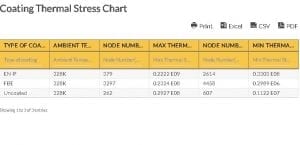Coating Thermal Stress Chart


Coating Thermal Stress Discussion
The impact of high temperature is determined through thermal stress. The thermal stress, which develops on the pipe wall, is also a factor in considering the ideal pipe material and size. In thermal analysis, two coatings are highly considered: the Electroless Nickel Phosphorous (EN-P)and Fusion Bonded Epoxy (FBE).
EN-P is a method that deposits noble metal on an active surface with less noble metal by putting an agent without utilizing electrical energy. This alloy coating is proven to be more sensitive compared to FBE. This means that there is a large possibility of stress corrosion cracking. It also has different types:
High Phosphorus
This coating is non-magnetic and has the lowest internal stress, which makes it the best EN (Electroless Nickel).
Medium Phosphorus
This coating has a melting point of 1,000 degrees C and has a faster plating rate, which leads to reduced cost compared to high phosphorous coating.
Low Phosphorus
This coating is a type of Electroless Nickel that is less ductile due to the presence of micro-crystalline. It is also the least corrosion resistant, yet it is more conductive in contrast to high and medium phosphorus.
Fusion Bonded Epoxy, on the other hand, is a powder coating that is originally a thermoset polymer. This has been recognized globally, since it does not only provide protection against corrosion but also enables any liquid to flow smoothly.
Coating Thermal Stress Benefits
The two coatings commonly used (EN-P and FBE) offer benefits that make customers opt for such products.
Compared to the other coatings, EN-P is less porous and makes steel pipes corrosion- resistant and durable. This can be applied with little compressive stress. In addition, it does not require electricity during operation, making it cost-effective. The operation also requires less coat and equipment, yet still creates a durable and high-quality pipe finish.
The FBE coating has strong adhesion on the surface. It also has high penetration resistance against harmful elements. In addition, it is highly reliable against soil stress, impact, water absorption, and abrasion. Best of all, FBE has long-lasting mechanical and chemical resistance under different temperatures and seasons
Coating Thermal Stress Chart
| Type of coating | Ambient Temperature (K) | Node Number(Max) | Max Thermal Stress Developed (Pa) | Node Number(Min) | Min Thermal Stress Dev. (Pa) | |
|---|---|---|---|---|---|---|
| wdt_ID | Type of coating | Ambient Temperature (K) | Node Number(Max) | Max Thermal Stress Developed (Pa) | Node Number(Min) | Min Thermal Stress Dev. (Pa) |
| 1 | EN-P | 328K | 379 | 0.2222 E09 | 2614 | 0.3303 E08 |
| 2 | FBE | 328K | 3297 | 0.2324 E08 | 4458 | 0.2989 E06 |
| 3 | Uncoated | 328K | 262 | 0.2927 E08 | 607 | 0.1122 E07 |
Coating Thermal Stress Chart
| Type of coating | Ambient Temperature (K) | Node Number(Max) | Max Thermal Stress Developed (Pa) | Node Number(Min) | Min Thermal Stress Dev. (Pa) | |
|---|---|---|---|---|---|---|
| wdt_ID | Type of coating | Ambient Temperature (K) | Node Number(Max) | Max Thermal Stress Developed (Pa) | Node Number(Min) | Min Thermal Stress Dev. (Pa) |
| 1 | EN-P | 328K | 379 | 0.2222 E09 | 2614 | 0.3303 E08 |
| 2 | FBE | 328K | 3297 | 0.2324 E08 | 4458 | 0.2989 E06 |
| 3 | Uncoated | 328K | 262 | 0.2927 E08 | 607 | 0.1122 E07 |
In the Table for Coating Thermal Stress, EN-P stands for Electroless Nickel Phosphorous coating while FBE means Fusion Bonded Epoxy coating.
Coating Thermal Stress Chart Abbreviations:
- EN-P – Electroless Nickel Phosphorous
- FBE – Fusion Bonded Epoxy
- W/m2 – watt per square meter
Go here if you are looking for the Coating Thermal Performance Chart.


